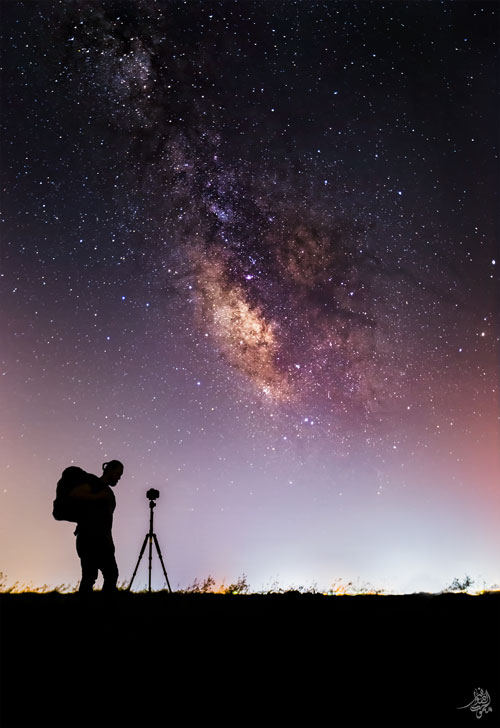Thought of as one of the most technical genres of photography, astrophotography can seem daunting to beginners. But if you’re looking to capture the night skies in all its glory, it’s not as hard as one might think! Astrophotographer Mahmood Alsawaf shares some common mistakes to avoid, and best practices to capturing the Milky Way or star trails.

EOS 5D Mark III, EF16-35mm f/2.8L II USM lens, 16mm, 20sec, f/2.8, ISO3200
Beyond The Horizon
What are some common mistakes beginners make when shooting astrophotography?
1. Shooting the Milky Way in JPG format
You should always shoot in RAW format because if you shooting in JPG, you will lose a lot of important data that you’ll need during post-production. For star trail photos, you can capture the base exposure in RAW format (before dark), then you can change your camera settings to JPG format later for stars.
2. Setting up in the dark
Go to your location before sunset, choose a good foreground and set up your camera. You might not be able to correctly focus in the dark.
3. Bad planning
Avoid heading out to shoot in heavy, cloudy nights or when the moon is full or waxing/waning. Ideally, you should shoot on days where there is no moon, and you should always check weather conditions and the moon cycle before heading out.
4. Shooting in heavy light polluted areas
Get away from the city to avoid the light pollution because even if you have clear skies and no moon, light pollution will prevent you from getting a good picture.
5. Spending too much on your gear
Think your entry-level DSLR and kit lens isn’t up to task when it comes to shooting stars? Wrong! Just ensure you have the right settings and astrophotography conditions, with some knowledge in post-processing and you’ll get the beautiful image you envisioned.

EOS 5D Mark III, EF20mm f/2.8 USM lens, 20mm, 20sec, f/4, ISO400
Lonely
What kind of equipment would one need to get started?
A DSLR camera plus wide angle lens. I recommend the EOS 7D or EOS 60D, with an EF-S10-22mm f/3.5-4.5 USM lens or EF-S10-18mm f/4.5-5.6 IS STM lens as a versatile kit to start out with.

EOS 5D Mark III, EF16-35mm f/2.8L II USM lens, 29mm, 20sec, f/2.8, ISO3200
Photographer
If you want to shoot star trails, how do you achieve it and what do you avoid?
For star trail photography, the photographer should firstly, get away from the city to avoid the light pollution. He should also have a compass if he doesn’t know how to identify the four directions (North, South, East and West). This allows you to get different shapes for the star trail path in each direction. For example, if the camera faces North, you’ll get a circular star trail path.

EOS 5D Mark III, EF100mm f/2.8L Macro IS USM lens, 1/90sec, f/8, ISO200 (foreground image)
EOS 5D Mark III, EF16-35mm f/2.8L II USM lens, 25sec, f/2.8, ISO3200 (sky image)
EOS 5D Mark III, EF16-35mm f/2.8L II USM lens, 1/2sec, f/9, ISO200 (image of myself)
New Vision
Which camera settings should one use to capture stars at night?
Shooting stars in the night sky plays around the concept of exposure. Long exposures would be needed to allow more light in your shots, and at the same time, if your exposure is too long, the camera will capture the movement of the stars, which results in a blurred shot.
To avoid the occurrence of star trails (if that’s not what you’re after), the Rule of 500 can help us determine how long the exposure should be for a given focal length lens. This rule is particularly important when shooting the Milky Way.
Applying the Rule of 500:
500/focal length = the right shutter speed needed
E.g.: 500/20mm = 25 seconds (full frame cameras)
However, do note that if your camera has a crop factor, this should be included in your calculations. Some Canon cameras have a crop factor of 1.6, so your calculation would look like this:
500/focal length, multiplied by 1.6
E.g.: 500/20mm x 1.6 = 15 seconds

EOS 5D Mark III, EF16-35mm f/2.8L II USM lens, 25sec, f/2.8, ISO6400
Dreams Way
What are some apps you can recommend?
Star walk and Stellarium
Are there certain times of night/year you must avoid in order to shoot astrophotography?
Milky Way photography is conditional and depends on which part of the earth you’re located. For example, in my native Iraq, we can see and photograph the Milky Way from March to the end of September to the beginning of October.
For star trail photography, the time of the year doesn’t matter but bear in mind my previous tips of weather conditions and moon phases.
Receive the latest update on photography news, tips and tricks.
Be part of the SNAPSHOT Community.
Sign Up Now!About the Author
Mahmood Alsawaf is an Iraqi photographer living in Dohuk city. He entered the world of photography in 2013 through macro photography, his passion for the visual arts later leading him to discover other genres like landscape, cityscape, astrophotograpy, fine art and portraiture. He found a true calling in landscape and astrophotography, but is still partial to all other genres.
https://www.flickr.com/photos/128000939@N03/
https://500px.com/mahmoodalsawaf
https://www.instagram.com/mahmood.alsawaf/
https://www.facebook.com/Mahmood-Alsawaf-Photography-1115125118509590/

































